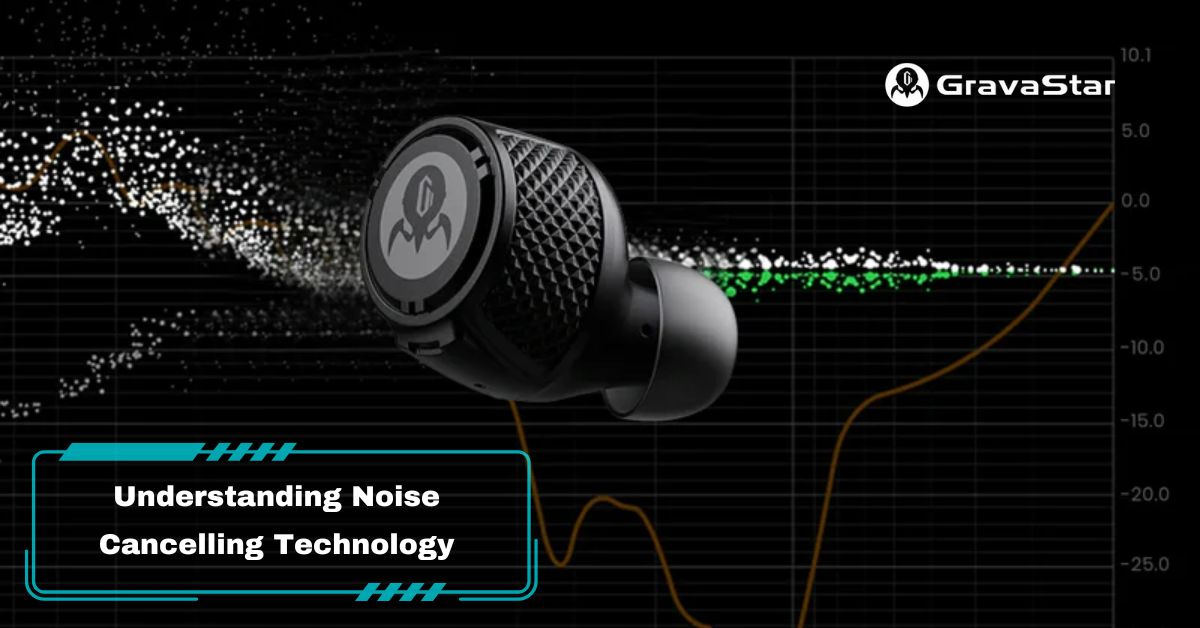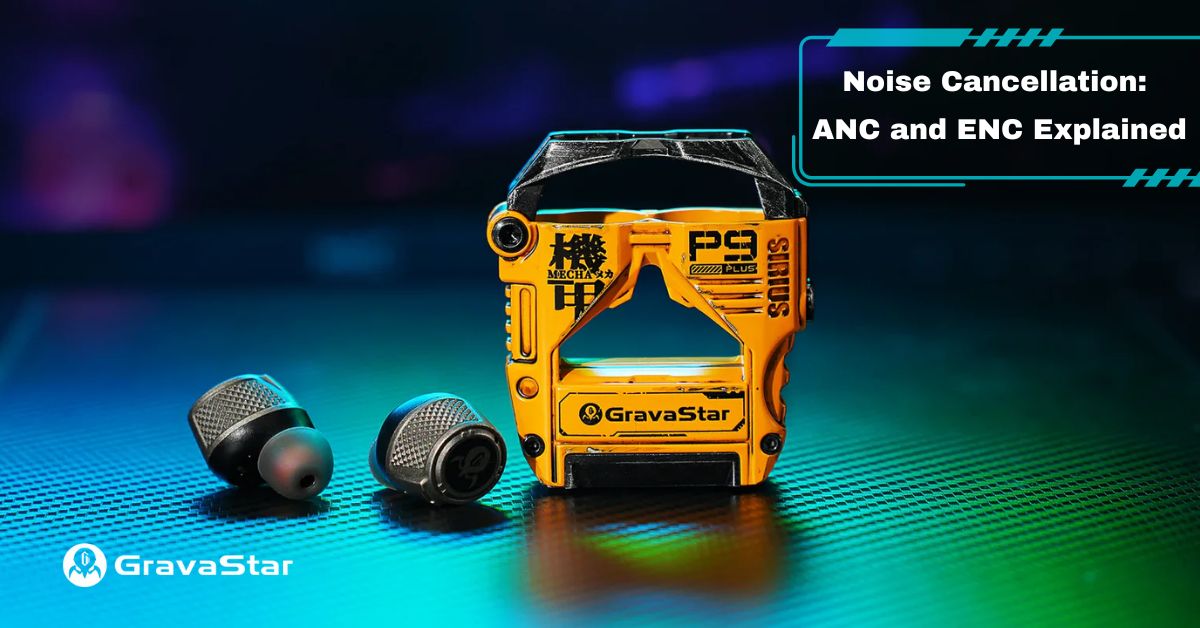Active Noise Cancellation (ANC) is a technology used in headphones and earbuds to reduce background noise. It works by detecting external sounds with microphones and producing opposing sound waves to cancel out unwanted noise.
This technology helps combat noise pollution (unwanted and harmful sound), which is a growing problem in workplaces and urban areas. In the United States, about 25% of workers have been exposed to hazardous noise, 22 million in the past year alone.
Outside the workplace, nearly 94.9 million people—about 30% of the population—are exposed to transportation noise levels of 45 decibels or more. About 11.9 million experienced noise levels exceeding 60 decibels from traffic, construction, and industrial activity.
Our Sirius Plus earbuds come with built-in ANC technology that both protects your ears from damage and enhances your listening experience. Try GravaStar for a next-level experience!
How Does Active Noise Cancellation Work?
Active Noise Cancellation (ANC) works through phase cancellation, where sound waves that are 180 degrees out of phase neutralize each other. It captures ambient noise, inverts its phase, and introduces this “anti-noise” into the audio output, reducing unwanted sounds before they reach your ear.

|
Step |
Process |
|
Microphone Technology |
Microphones placed outside and inside the headset detect ambient noise. External microphones capture environmental sounds, and internal microphones detect residual noise. |
|
Signal Processing |
Noise is analyzed for its frequency and strength using analog circuits or DSPs. The system creates an inverted “anti-noise” wave to counter the detected noise. |
|
Anti-Noise Generation |
The anti-noise signal is played through the speakers. It meets the original noise and cancels it out, reducing the sounds you don’t want to hear. |
What are the Benefits of Using Active Noise Cancellation?
Active Noise Cancellation (ANC) helps create a quieter environment, making it easier to focus, relax, and communicate in noisy settings. It reduces distractions and enhances the overall listening experience, whether for audio, calls, or sleep.
- Enjoy Clear Audio Anywhere: ANC blocks out distracting sounds, letting you hear music, podcasts, or play games without needing to increase the volume.
- Protect Your Hearing: By reducing background noise, ANC allows you to listen comfortably at lower volumes, lowering the risk of long-term hearing damage.
- Clearer Calls: ANC filters out unwanted background noise so your voice sounds clear during phone or video calls, even in noisy places like coffee shops or while traveling.
- Stay Focused in Noisy Environments: Whether working in a busy office or studying at home, ANC minimizes noise distractions to help you concentrate better.
- Reduce Stress During Travel: ANC reduces constant noises like engine hums, making flights, train rides, and long commutes more relaxing and less tiring.
What are the Different Types of Noise Cancellation Systems?
Active Noise Cancellation (ANC) systems are categorized into four types: feedforward, feedback, hybrid, and adaptive. Each type uses microphones and processing methods differently to reduce ambient noise, with adaptive ANC adding dynamic adjustment capabilities for changing environments.

Feedforward ANC
Feedforward ANC places a microphone on the outside of the earbud or headset to detect noise before it enters the ear. The system processes this noise and generates an opposite sound wave to cancel it out. This type is particularly effective for high-frequency noise and allows features like the “side tone” function, which lets users hear external sounds or their own voice during calls.
Feedback ANC
In this system, a microphone is placed inside the earpiece to detect noise that has already reached the ear canal. This placement allows for accurate noise detection regardless of how well the ANC earbuds or over-ear headphones fit. It also offers a few extra decibels of noise reduction compared to other methods.
Hybrid ANC
By combining feedforward and feedback technologies, hybrid active noise cancellation uses microphones positioned both inside and outside the earpiece.
This dual-microphone setup provides maximum noise reduction across a wide range of frequencies, reduces feedback issues, and supports features like ambient noise control and improved sound isolation. This makes it suitable for various environments.
Adaptive ANC
Adaptive ANC adjusts noise cancellation in real-time based on the sounds around you. It uses microphones to monitor the environment and changes the noise cancellation levels automatically. This makes it ideal for places with changing noise, like a busy street or an airport, offering a better listening experience in unpredictable settings.
What’s the Difference Between Active vs Passive Noise Cancelling?
The biggest difference between active and passive noise cancellation is that active noise cancellation uses technology to block out noise, while passive noise cancellation relies on the physical design of the headphones to reduce external sounds.
|
Aspect |
Active Noise Cancellation (ANC) |
Passive Noise Cancellation (PNC) |
|
Method |
Uses microphones to detect external sounds and electronics to generate opposing sound waves to cancel them. |
Relies on physical barriers (ear cups, ear tips) to block external noise. |
|
Effectiveness |
Works well for reducing consistent, low-frequency noises like engine hums. |
Better at blocking high-frequency sounds through soundproofing materials and design. |
|
Power Requirement |
Requires a power source, such as batteries, to operate the electronic components. |
Does not need a power source, as it relies entirely on the physical construction of the headphones. |
|
Impact on Sound Quality |
May slightly alter the original sound due to the addition of anti-noise signals, though advancements in technology have minimized this effect. |
Does not affect the original sound quality, as no electronic processing is involved. |
|
Battery Life |
Reduces playback time due to power consumption for noise cancellation. |
Does not impact battery life, as it doesn’t require power. |
|
Comfort and Design |
May cause slight pressure or discomfort for some users due to the anti-noise waves; designs are often bulkier to house electronic components. |
Generally lighter and more streamlined, making them more comfortable for extended wear. |
|
Cost |
Costs more due to advanced electronic components and technology. |
Costs less, as it lacks complex electronics and relies on simpler design elements. |
|
Best For |
Works well in environments with steady, low-frequency noise, like airplanes, trains, or busy offices. |
Ideal for managing higher-frequency noises or when a simpler design is preferred. |
Combining Active and Passive Noise Cancellation
Active Noise Cancellation (ANC) and Passive Noise Cancellation (PNC) work together to block unwanted sounds.
PNC uses materials like cushioned ear cups or snug-fitting ear tips to block higher-frequency sounds. ANC reduces low-frequency noises, like engine hums, by using microphones and sound waves to cancel them. Together, they create a simple and effective way to reduce noise.
For example, over-ear noise cancelling headphones use padded ear cups to block outside noise (PNC), while built-in ANC reduces lower-frequency sounds. In-ear headphones fit tightly to block noise (PNC) and use ANC to cancel surrounding noise. This makes it easier to enjoy clear audio without adjusting volume in noisy places.
What Factors Can Influence Noise Cancellation?
The effectiveness of noise cancellation technology depends on several factors. These include the type of noise being canceled, the quality and placement of microphones, the device's processing power, the fit and design of the device, and the specific noise cancellation algorithm used.
Other factors that can affect noise cancellation include:
Technical Constraints
Battery life plays a big role in the performance of ANC devices, as lower battery levels can reduce the efficiency of noise cancellation. The quality of the audio may also be affected by the processing power of the device, especially in budget models where faster ambient noise changes may not be handled smoothly.
Environmental Factors
Environmental conditions like wind noise and sudden changes in surrounding sounds can interfere with ANC performance. Humidity, temperature, and atmospheric pressure can also affect the way sound waves interact with the ANC system, particularly in outdoor or extreme conditions.
Frequency Ranges
ANC works most effectively with steady, mid- to low-frequency sounds like engine hums or air conditioning. These systems are best at canceling out noises with frequencies between 300 and 400 Hz, which are constant and low-pitched. Sudden changes in pitch or variable sounds, such as conversations, are more difficult for ANC to process quickly.
Device Positioning
The positioning and fit of ANC headphones or earbuds affect their performance. A poor fit can allow external noise to leak in, reducing the effectiveness of both passive and active noise cancellation systems.
Browse through our earphone collection to find the GravaStar buds that are right for you! The Sirius Plus features ANC, while the Sirius P5 has built-in advanced environmental noise-cancelling technology.
What Is Active Noise Cancellation? | FAQs
Where is Active Noise Cancellation Used Most?
Active Noise Cancellation technology is mainly used in consumer electronics and transportation sectors.
- Consumer Electronics: Used in noise-cancelling headphones and earphones to reduce ambient sound and improve the listening experience. Many smartphones use ANC for better call quality.
- Transportation: Vehicles are designed with ANC systems to reduce engine and road noise. Commercial airline headsets also include this technology.
Do ANC Devices Work Without Playing Music or Audio?
Yes, ANC technology can function without audio playback. Many devices allow users to activate ANC in “silent mode” to reduce environmental noise without playing any sounds.





Leave a comment
This site is protected by hCaptcha and the hCaptcha Privacy Policy and Terms of Service apply.